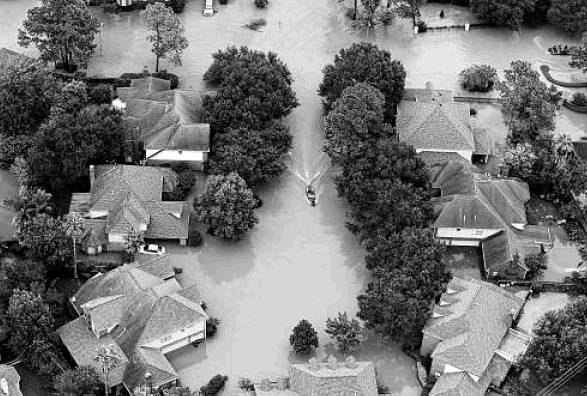Attorneys argue again over Harvey flooding
By Emily Foxhall STAFF WRITER
Federal appellate judges listened to two attorneys make their cases Wednesday over the question of whether the U.S. government is liable for widespread flooding that occurred downstream of Addicks and Barker reservoirs after Hurricane Harvey hit more than four years ago.
On one side, Russell Post, representing the flooded property owners, argued that they should not be responsible for the damage from the U.S. Army Corps of Engineers’ decision to release water from behind the dams as a precautionary — not emergency — measure.
“The hurricane did not flood these properties,” Post said. “They flooded because the government opened the flood gates.”
On the other side, Brian Toth, representing the federal government, said the properties would have faced worse damage had the massive reservoirs and dams not been built. He noted that the gates were initially closed to protect them and only opened days later in accordance with an operations manual.
“It was the Corps’ operation of the project during the entire storm that is at issue and that should be looked at,” Toth told the panel of three judges.
Addicks and Barker reservoirs sit on the west side of Houston and are normally dry; people walk and exercise alongside and behind the u-shaped dams. They were built in the 1940s to address flood concerns but were meant to be part of a larger flood control system that was never completed.
The city of Houston continued to develop, and climate change set the stage for stronger hurricanes, with harder rains. Harvey dropped so much water in late August and September 2017 that those reservoirs were put to the test; homeowners who were previously unaware their houses sat in the reservoirs watched them flood, and stormwater flowed around one end of the Addicks dam.
Operators opened the gates before the area had time to drain, sending floodwater pouring into Buffalo Bayou toward already rain-soaked neighborhoods.
Property owners both upstream of the dam and downstream along the bayou sued in the U.S. Court of Federal Claims, arguing their damage was the government’s fault. A judge ruled the Corps was indeed liable for damage to the upstream homes. A trial is tentatively set for March to determine what is owed them.
But the outcome in that court was different for those downstream of the dams. A separate judge in September 2020 dismissed their lawsuits. He explained in a ruling that the hurricane was to blame and homeowners weren’t entitled to “perfect flood control.”
Attorneys appealed that decision, hence the arguments Wednesday. The attorney for the plaintiffs, Post, said they were not claiming they had a right to perfect flood control. Instead, he argued that previous lawsuits showed a right for them to be free of a “flowage easement,” meaning the government didn’t have a right to take and flood their land.
Post said that it made no sense for the upstream and downstream cases to be decided differently: “I think that’s a conflict that this court cannot tolerate, when you have the same question decided arising out of the same event by two members of the Court of Federal Claims,” he said.
Toth, of course, disagreed.
“The Court of Federal claims dismissed plaintiffs’ claims, and for the numerous reasons outlined in our brief, that dismissal was correct,” he said.
The intricate arguments moved at a rapid-fire pace, with only about 30 minutes total for both to make their cases by phone. Both attorneys picked apart various pieces of nuanced, earlier court decisions, pointing to what both state and federal law says about property rights and flood control.
The attorneys for the plaintiffs expect to hear an answer in three to six months.
The case could be returned to the federal claims court. Or, if they fail on the appeal, they will be forced to decide whether to let the case go or appeal once more, this time to the U.S. Supreme Court. emily.foxhall@chron.com
